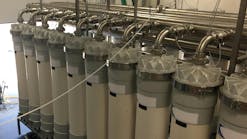Let’s just say it — wastewater management can feel like a burden. No matter what industry you are in, dealing with wastewater is rarely the focus.
But the reality is that if wastewater is not properly managed, it can spiral into production disruptions, excessive costs and even legal trouble. Many facility managers underestimate the complexity of wastewater management when they first take it on, only to find themselves overwhelmed by the headache it brings.
The true burden of wastewater management
Wastewater management might sound straightforward, especially since it is produced directly at your facility as a byproduct of your processes. In reality, managing and treating these streams can be a complex, demanding task that requires constant oversight and highly specific conditions to work effectively.
For food and beverage (F&B) manufacturers and other industrial operations, the challenge only grows. Here are some aspects you may not have thought of that contribute to the burden of wastewater:
1. Isolating the problem
Most of the problematic organic pollutant is associated with only a few, small volume, processes in your production and cleaning cycles. Understanding this discharge and isolating these streams in new or existing production facilities can save a lot space, headache and cost when it comes to treatment.
2. Choosing the right treatment method
Selecting the best way to treat wastewater requires an in-depth analysis of the wastewater you produce. With varying water quality, production levels and regulatory requirements, choosing the right method is a balancing act between efficiency, compliance, environmental impact and cost. Picking the wrong method can drive up costs (often unnecessarily), create unintended impacts to down-stream processes and/or leave you out of compliance.
2. Monitoring systems around the clock
In industrial settings, production never truly stops — and neither does wastewater generation. Things can change overnight and without constant monitoring, you risk unmanageable sludge, negative impacts to existing treatment schemes, water loss and/or other hazards to safety, compliance and production schedules. Effective real-time monitoring and automation of production flows catches issues before they become costly problems, but it requires investment in both personnel and technology.
3. Maintaining equipment
From pumps to sensors, wastewater treatment systems require regular upkeep to prevent costly downtime. Equipment failures can lead to inefficiencies (slowdowns) or even complete shutdowns — interrupting production and creating revenue losses. Maintenance requires not only addressing mechanical wear and tear for equipment, but also scheduling downtime for cleaning (especially equipment and tanks associated with sludge management) and keeping essential spare parts and chemicals in stock.
4. Staying compliant with regulations
Environmental regulations can be strict, especially for industries producing high-organic wastewater, like F&B; or complex organic pollutants like chemical, textile or petrochemical industries. Obtaining and maintaining permits, self-monitoring or third-party monitoring programs, submitting regular testing reports and adapting processes to evolving standards are all part of staying compliant.
Being out of compliance can lead to steep fines, halted production and reputation damage. The issue is that these regulations and permit requirements are always changing, so you need to constantly stay up to date to ensure compliance and be able to predict how changing costs may impact the bottom line.
5. Sludge management
Perhaps one of the biggest challenges in wastewater management is handling sludge — a byproduct of biological treatment that requires separation, collection, dewatering and disposal. Sludge testing is also required to determine how it can be disposed, either through land application (can occasionally generate a revenue) or to landfill (if sludge contains heavy metals or toxic pollutants). These activities are costly and time-intensive and come with business risks and environmental impacts of their own.
There are even more aspects to wastewater management that we haven’t captured here, like balancing sustainability and circularity efforts with effective treatment, managing production expansions/changes and coordinating discharge with local utilities.
All that to say — wastewater management is a lot. Without staying on top of these factors, your upstream production will suffer.
The operational demands of wastewater management are substantial, but they don’t have to be your burden. By partnering with a company like Aquacycl, you can delegate these responsibilities to a dedicated team of experts with one mission: simplifying wastewater management.


